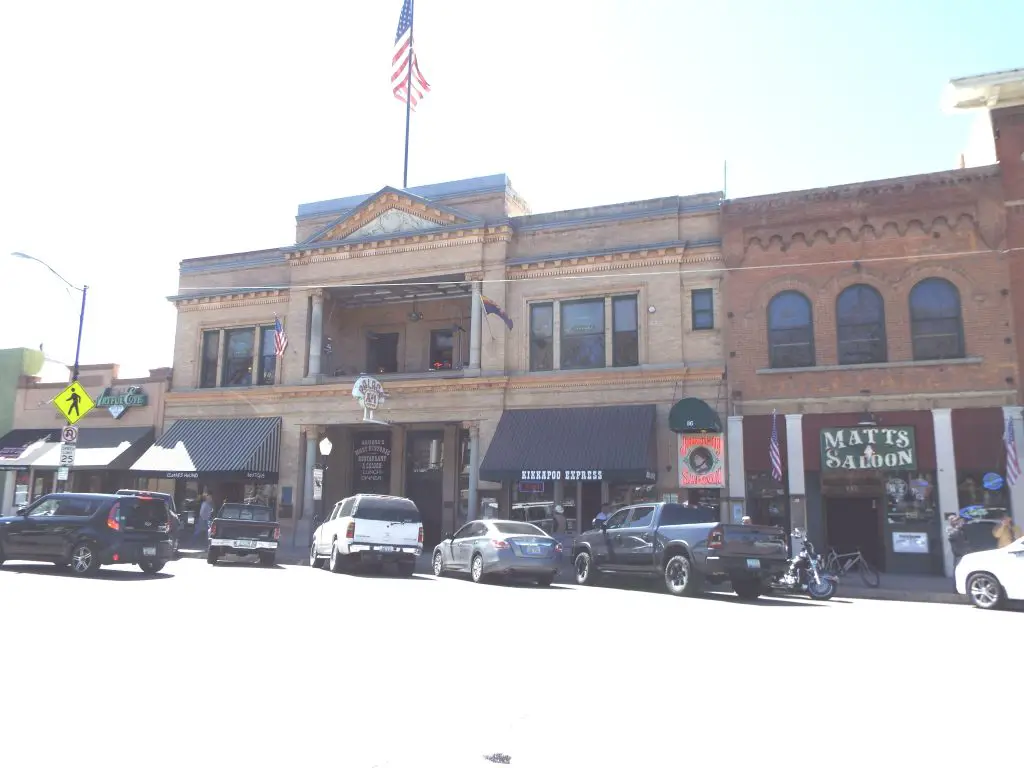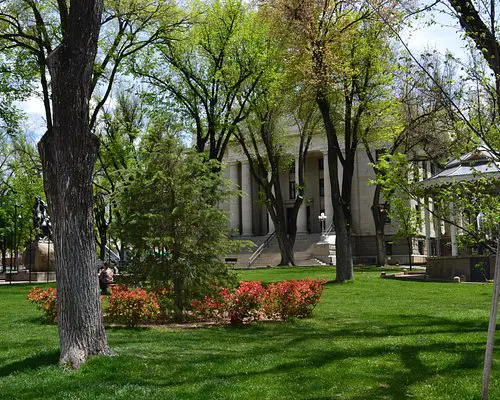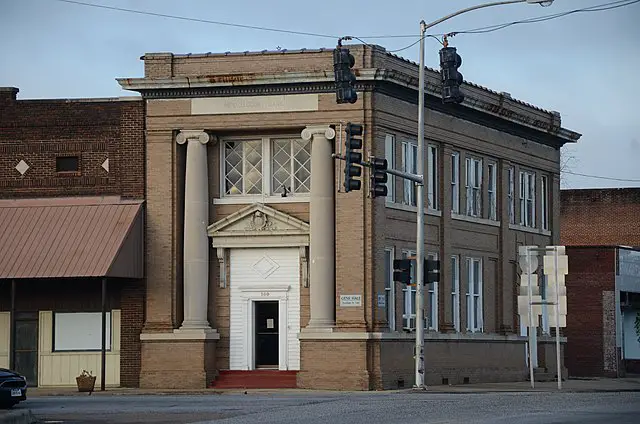Prescott, a city drenched in history, is a tapestry of stories woven from its old buildings, streets, and landmarks. Notable historic districts in Prescott and their significance aren’t just dates and events; they’re the heartbeat of a community that has seen much and grown immensely.

Walking through these districts is akin to flipping through the pages of a living history book, offering glimpses into the city’s vibrant past.
The Importance of Historic Districts
The importance of historic districts lies in their role as living monuments to a community’s past, present, and future. They are not just remnants of history but vibrant neighborhoods that reflect the cultural, architectural, and social evolution of a place.
From preserving architectural marvels to nurturing traditions and fostering community pride, historic districts serve as a tangible link to heritage. In places like Prescott, these districts provide educational experiences, boost local economies through tourism, and contribute to a sense of identity and continuity, underscoring why their preservation and celebration are vital.
Cultural Heritage Preservation
Cultural heritage is the essence of any society. By preserving historic districts, we keep alive the tales, traditions, and artifacts that tell the story of our ancestors. This is paramount to understanding who we are and where we come from.
The National Trust for Historic Preservation emphasizes that through the conservation of historic places, we maintain a visible connection to our roots.
Economic Benefits
Historic districts often attract tourists, researchers, and history enthusiasts. This influx of visitors can greatly benefit the local economy. Restoration projects also create jobs, and businesses thrive in these historic areas, providing both immediate and long-term economic advantages. The Advisory Council on Historic Preservation has detailed data showing how historic preservation significantly contributes to the U.S. economy.
Educational Opportunities
History provides crucial lessons. Having tangible reminders of the past, like historic districts, serves as educational tools for both young and old. Schools can organize field trips, researchers can delve into archives, and visitors can partake in guided tours.
Organizations like the American Historical Association work tirelessly to promote history education.
Historic districts preserve the unique identity of a community. They offer an aesthetic appeal with their well-preserved architecture and layouts.

Living or working in these districts can instill a sense of pride among residents, knowing they’re a part of something bigger than themselves.
Whiskey Row
Whiskey Row, located in Prescott, Arizona, is an iconic block known for its vibrant history and lively atmosphere. Once home to over 40 saloons in the late 19th century, it became a hub for miners, cowboys, and other frontier folk looking for entertainment and camaraderie.
Today, Whiskey Row continues to capture the Wild West spirit, hosting an array of bars, shops, restaurants, and galleries within its historic buildings. Visitors can immerse themselves in the rich cultural legacy of the area, enjoying modern amenities while soaking in the nostalgia of an era gone by.
It’s a must-see destination for anyone interested in experiencing a slice of Prescott’s colorful history.
History and Development
Whiskey Row dates back to the gold rush days of Prescott. Originally a red-light district, it transformed into a bustling hub with saloons, hotels, and mercantile establishments. The City of Prescott website has a comprehensive history of the development of Whiskey Row over the years.
The buildings on Whiskey Row reflect a blend of Victorian and Western Revival architecture. Intricate wooden facades, large windows, and ornate detailing are prominent features. These structures have withstood fires, weather, and time, symbolizing resilience and endurance.
Whiskey Row was synonymous with the Wild West. Saloons were frequented by outlaws, miners, and cowboys. The street witnessed duels, celebrated gold finds, and mourned losses. Sites like the HistoryNet often feature articles discussing the Wild West and the pivotal role streets like Whiskey Row played in shaping it.
Victorian Homes on Mount Vernon Street
The Victorian Homes on Mount Vernon Street is a distinguished feature of Prescott, Arizona, showcasing the city’s architectural elegance and historical charm. This picturesque street, lined with stately Victorian residences, transports visitors back to a bygone era, providing a glimpse of Prescott’s affluence and style during the late 19th and early 20th centuries.
Many of these beautifully preserved homes feature intricate details, ornate woodwork, and classic Victorian design elements. Some are even open to the public for guided tours, allowing a more intimate look at the interior splendor and rich history.
A stroll down Mount Vernon Street is not only a visual delight but also a meaningful connection to Prescott’s cultural and architectural heritage, symbolizing the city’s preservation of its distinct identity.
Overview of Victorian Architecture
The Victorian era’s architectural richness is renowned, marked by ornate details, asymmetry, steep roofs, and diverse materials. Victorian homes exude elegance, and the late 19th and early 20th centuries were the pinnacle of this style.
It has continued to influence contemporary designs and remains a symbol of affluence and taste. For more on Victorian architecture, visit the Victorian Society’s website.
Mount Vernon Street is a living museum of Prescott’s golden Victorian era. The street’s elegant homes reflect a time when Prescott was flourishing economically and culturally. These buildings housed prominent residents and thriving businesses, shaping the city’s socio-economic fabric.
The Victorian charm of Mount Vernon Street continues to attract visitors and is a symbol of Prescott’s rich past.
Preservation Efforts
Preserving these historic homes has become paramount in retaining the area’s unique charm. Through collaborative efforts by local groups, residents, and the government, many of the structures have been carefully restored. These restoration projects are not merely aesthetic endeavors; they ensure that the homes’ histories and architectural brilliance are not lost to time.

Several of the Victorian homes on Mount Vernon Street are open to the public for guided tours. Visitors can walk through the elegantly furnished rooms, enjoying the intricate woodwork and learning about the families who once lived there. Guided tours offer a rare glimpse into Prescott’s Victorian past, a journey that is both educational and awe-inspiring.
Hassayampa Historic District
The Hassayampa Historic District in Prescott, Arizona, is a captivating blend of history, architecture, and culture. Named after the nearby Hassayampa River, the district is renowned for its Native American roots and diverse architectural styles, ranging from Victorian to Bungalow designs.
Over the years, concerted efforts have been made to revitalize the area, leading to an economic resurgence that has embraced both tradition and modernity. Today, the Hassayampa Historic District is a thriving community hub, hosting various events and cultural activities that celebrate its unique heritage.
The blend of history and contemporary energy makes it a dynamic and engaging place to explore, offering a rich insight into Prescott’s multifaceted identity.
Native American Roots
The name ‘Hassayampa’ derives from the Native American word meaning ‘river that loses itself.’ The area’s roots are deeply tied to Native American tribes that once thrived in this region. These native connections lend the Hassayampa Historic District its unique identity and historical depth, which are celebrated and preserved in local traditions.
The Hassayampa Historic District is architecturally diverse, boasting a mix of craftsman bungalows, revival-style buildings, and other unique styles. Each structure encapsulates a different period, preserving history through brick and mortar. This blend of designs tells a rich architectural story, attracting both historians and architecture enthusiasts to the district.
Economic Impact and Revitalization
The Hassayampa Historic District is more than just a hub of history and architecture; it’s an economic catalyst. The district’s blend of residential, commercial, and cultural spaces has attracted investment, tourism, and revitalization. Through sensitive redevelopment and engagement with the community, the area has managed to blend the old with the new, enhancing its economic vitality.
Throughout the year, the Hassayampa Historic District plays host to numerous cultural events and activities. From art exhibitions to community festivals, the area is abuzz with creativity and celebration. These events foster a sense of community and cultural pride, connecting residents and visitors alike to the district’s rich heritage.
Fort Whipple
Fort Whipple, situated in Prescott, Arizona, stands as a historical landmark with multifaceted significance. Established in 1864, it played a vital role as a military post during various conflicts and served as a tactical center in the region. Beyond its military importance, Fort Whipple also has an intriguing medical history, having functioned as a hospital that treated soldiers and local citizens.
Today, the Fort Whipple Museum invites visitors to explore this rich past, offering exhibits on military, medical, and architectural themes. This well-preserved site not only commemorates the bravery and sacrifices of those who served but also provides insights into the broader social and cultural context of the time.
Its enduring presence is a reminder of the complex tapestry of American history as reflected in Prescott’s local story.
Military Importance
Established during the American Civil War, Fort Whipple’s military significance cannot be overstated. It served as a tactical base, housing troops and overseeing the region’s military operations. The Fort’s strategic importance extended beyond the Civil War, shaping military decisions and actions that have left a lasting impact on Prescott’s history.
Fort Whipple’s medical history is an intriguing chapter. Initially serving as a military hospital, it treated soldiers from various wars and conflicts. Over time, the facility evolved to tackle other diseases and medical challenges. Today, the Fort stands as a testament to the evolution of medical practices and a reminder of the lives saved and lost within its walls.
Architectural Significance
The diverse architectural structures within Fort Whipple offer insights into military life during different periods. From barracks to hospitals, the preservation of these structures provides tangible connections to history. Architectural tours and exhibits offer visitors a chance to appreciate these buildings’ significance and the role they played in shaping Prescott’s military legacy.
The Fort Whipple Museum offers interactive experiences that allow visitors to delve into its multifaceted history. Educational programs for schools and enthusiasts provide a hands-on approach to understanding military strategies, medical practices, and everyday life at the Fort. The museum serves as a dynamic space, bridging past and present, and connecting people to a shared heritage.
Pleasant Street Historic District
The Pleasant Street Historic District represents Prescott’s residential evolution. From modest homes to architectural masterpieces, the area showcases a rich tapestry of designs and historical periods. Pleasant Street tells the story of suburban growth and transformation, echoing the aspirations and changes of its residents over time.
Community involvement has played a vital role in shaping and preserving Pleasant Street. Residents, local organizations, and authorities have collaborated to maintain the area’s character and significance. The sense of community pride and ownership has fostered a vibrant local culture, making Pleasant Street a beloved part of Prescott’s heritage.
Architectural Styles
Pleasant Street is a visual timeline of architectural trends, from bungalows to contemporary homes. The variety of styles mirrors the changing tastes, technologies, and sensibilities of different eras. This architectural diversity not only adds visual appeal but serves as a tangible record of the district’s growth and transformation.

Efforts to preserve Pleasant Street’s historical integrity continue, with ongoing collaborations between local authorities and residents. Through careful planning and regulation, the district’s architectural treasures are protected, ensuring that future generations can appreciate its historical and aesthetic significance.
The Citizens Cemetery
The Citizens Cemetery in Prescott, Arizona, is more than a final resting place; it’s a historical treasure trove that narrates the city’s rich past. Established in 1864, this cemetery hosts the graves of various notable figures, including pioneers, miners, soldiers, and early settlers. Each tombstone tells a unique story, weaving a complex tapestry of life, struggle, triumph, and heritage.
The cemetery is a somber yet fascinating destination, where visitors can embark on guided tours to delve into the history and significance of the area. Preservation and maintenance efforts have kept this hallowed ground as a poignant connection to Prescott’s early days, ensuring its role as a valuable cultural landmark.
History and Significance
Founded in 1864, the Citizens Cemetery is not just a resting place but a chronicle of Prescott’s past. It serves as a historical marker, housing the graves of pioneers, soldiers, politicians, and other significant figures. The stories etched into the gravestones reflect the triumphs and tribulations of a growing city.
Preserving the Citizens Cemetery is a matter of historical responsibility and respect.
Through diligent maintenance and restoration projects, the area has been kept in a state that honors those buried there. These efforts not only protect the physical site but preserve the stories and significance it holds.
Graves of Notable Figures
The cemetery is the final resting place for many notable figures who played key roles in shaping Prescott’s history. From local leaders to unsung heroes, each grave tells a unique story. Guided tours and interpretive panels provide insights into these individuals’ lives, connecting visitors to Prescott’s multifaceted history.
Cemetery tours offer a unique and reflective experience, allowing visitors to connect with the lives that shaped Prescott. Guided by knowledgeable historians, these tours are more than a walk among tombstones; they’re an exploration of history, emotion, and heritage. The cemetery becomes a classroom, imparting lessons from the past.
Elks Opera House
The Elks Opera House in Prescott, Arizona, is a shining testament to the city’s cultural heritage. Opened in 1905, this historic venue has become an enduring symbol of Prescott’s commitment to the arts. With its grand Italianate façade and ornate interior, it stands as a beacon of architectural elegance.
But beyond its visual charm, the Elks Opera House remains a vibrant center for entertainment, hosting a diverse array of performances that range from classic theater to contemporary music. Its seamless blend of history, beauty, and modern function make it a beloved institution in Prescott’s artistic landscape, attracting both locals and tourists alike.
Entertainment History
The Opera House’s storied history is filled with famous performers and unforgettable productions, making it a treasured part of the city’s artistic legacy.
Designed in the Italianate and Classical Revival styles, the Elks Opera House is an architectural gem. Its ornate façade, grand auditorium, and intricate detailing showcase the artistic ambitions of its time.
This architectural grandeur has been meticulously preserved, providing a fitting venue for the vibrant performances that grace its stage.
Renovation and Preservation
Over the years, renovation and preservation efforts have ensured that the Elks Opera House remains a vibrant part of Prescott’s cultural landscape. Utilizing both private and public funding, the community has rallied to keep the venue’s historic charm intact while upgrading its facilities.
The Opera House’s continuous evolution illustrates Prescott’s dedication to its cultural heritage.
Modern Usage and Performances
Today, the Elks Opera House continues to be a bustling center for entertainment. Hosting everything from classic theater to contemporary concerts, it remains a vital part of Prescott’s arts community.
The Opera House’s modern usage is a testament to its timeless appeal, bridging generations through a shared love for performance and culture.
Frequently Asked Questions:
In this section, we will be delving into some of the most common inquiries and curiosities that surround our topic.
Can I take a tour of the Victorian homes on Mount Vernon Street?
Yes, several homes offer guided tours, providing a glimpse into Prescott’s Victorian era.
What types of events are hosted in the Hassayampa Historic District?
The district hosts various cultural events, from art exhibitions to community festivals.
Is Fort Whipple open to the public?
Yes, the Fort Whipple Museum offers interactive experiences and educational programs for visitors.
How can I get involved in preserving Pleasant Street Historic District?
Local organizations often welcome volunteers and support for preservation efforts.
Are there guided tours available at the Citizens Cemetery?
Yes, guided tours offer insights into the lives and stories of those buried there.
Can I book tickets for a performance at the Elks Opera House online?
Yes, tickets for performances can typically be purchased online through the Opera House’s official website.
Conclusion
Prescott’s historic districts are more than mere relics of the past; they are living repositories of culture, architecture, and history. From the elegance of Victorian homes to the vibrant arts scene at the Elks Opera House, these districts weave together the threads of Prescott’s rich tapestry.
Preservation, community involvement, and a love for history have ensured that these stories continue to resonate. Whether exploring military history at Fort Whipple or taking part in cultural events in Hassayampa, Prescott’s historic districts invite everyone to experience and cherish a shared heritage.



Leave a Comment
You must be logged in to post a comment.